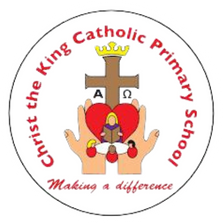ART
Our Mission Statement
'Making a difference by inspiring a love of life and learning for all. We build strong foundations within God's loving hands'.
Our Core Values
We provide a Catholic Christian education based on the life and teaching of Jesus Christ. Our Core Values. Our Core Values are inspired by Gospel values and stem from love - love is forgiveness, sharing and kindness. They are:
- Responsibility
- Compassion
- Respect
- Honesty
- Perseverance
- Courage
At Christ the King Catholic Primary School we inspire our children to have a lifelong love of learning through a broad, enriched and balanced curriculum. We aspire for all children to be the best they can be and make a difference to our world by building strong foundations within God’s loving hands.
Our Approach, Aim, and Curriculum
Our key curriculum drivers are:
- Inclusivity
- Creativity
- Curiosity
- Oracy
Intent
At Christ the King Catholic Primary School, we aim to inspire a lifelong curiosity about art. Art teaching at Christ the King ensures that all pupils develop their ability, nurture their talents and interests and express their ideas and thoughts about art.
Pupils will learn about the formal elements of Art and specific skills in Art and Design. They will learn about a range of artists from the past and the present and will learn how to analyse works of art. They will also learn specific language to help them explain and evaluate their own work and the work of others.
Skills taught will look at colour through colour mixing, form through 3D work, line through drawing, pattern, shape and texture through art, craft and design.
Art learning will be linked to other subject areas where applicable, developing our cross-curricular approach. The National Curriculum informs our chosen topics, which are sequential and include progression of skills. They aim to inspire pupils and develop their confidence to experiment and create their own works of art. Children will understand how Catholic Virtues and British Values relate to art. There will be opportunities beyond the classroom for real life learning and for pupils to visit museums and galleries and experience a range of rich and varied cultures.
Implementation
Art is taught in blocks throughout the year so that children develop a deep and secure understanding. There are also links between Art and other areas of the curriculum where appropriate and where it adds value to both the subjects. Skills are built on year on year and sequenced appropriately throughout the school and lessons are planned using this document. Monitoring occurs regularly by the Curriculum Lead.
Children cover 4 units each year from the Kapow Primary Art scheme of work. The lessons in each unit are taught in sequential order with the exception of the skills and formal elements which can be taught as stand alone lessons and taught in any order.
Across all the unit the following will be covered:
- Making skills: Learning a range of skills and techniques to create pieces of art
- Generating ideas: Through class discussion and understanding the development of art forms
- Knowledge of Artists: Comparing artists work looking for similarities, differences, strengths and weaknesses
- Formal Elements: Colour, form, line, shape, pattern, texture
- Evaluating: Talking about and analysing their own and others artwork
Time is available throughout the year to allow children to revisit and use the skills they have learnt in our scheme of work so they can explore their own creativity. This time also provides the flexibility to have cross-curricular links where appropriate. Children given opportunities to use sketchbooks and these are used throughout the year to practice skills and develop their own creativity and artistic style.
Each unit has a knowledge organiser which is shared with children and parents. Assessment Quiz and Knowledge Catchers are used at the start of the unit to assess where pupils are at the start of their learning and at the end of the unit to assess progress. Teacher demonstration videos help the staff have a clear understanding of what and how to teach particular skills and techniques. Pupil demonstration videos are used to support children when learning new skills. These can be used multiple times to help those children who may need further support.
Impact
By the time pupils leave they will:
- Be confident to produce creative work, exploring and recording their ideas and experiences
- Be proficient in age related skills in drawing, painting, sculpture and other art, craft and design techniques
- Evaluate and analyse creative works using subject specific language
- Know facts and key information about art and be able to talk about and use a range of skills
- Know about great artists and the historical and cultural development of art
- Have developed a range of techniques, confidence and creativity, which will form a strong foundation for their Art and Design learning
- Talk confidently about their own learning journey in Art
We will measure the impact of our curriculum through the following methods:
- Each unit has a unit quiz and knowledge catcher which are used at the start and/or end of the unit
- Examples of children’s work
- Images of children’s work stored in class folders on the J drive
- Pupil voice
- Moderation staff meetings
- Sketchbooks show progression of skills taught are being used independently by the children
- Children talk about their own and others art and are making decisions about the quality of their outcomes and the improvements they need to make in their art work

